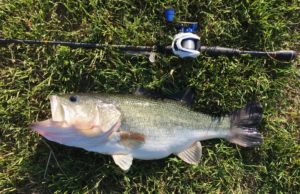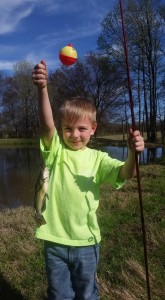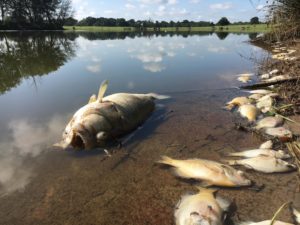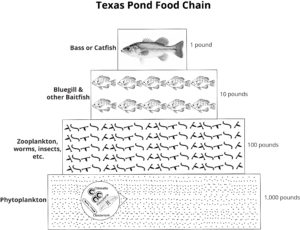
COLLEGE STATION – Pond health and maintenance should be a top priority for landowners who want to get the most out of their favorite fishing hole, said a Texas A&M AgriLife Extension Service expert.
Dr. Todd Sink, AgriLife Extension aquaculture specialist, College Station, said maintaining ponds is critical to increasing fish productivity and avoiding fish kills.
Environmental factors like declining dissolved oxygen during peak summer months or inhospitable pH and alkalinity levels can lead to major problems in stock ponds, Sink said.
“Summer is coming,” he said. “Right now is a good time to be planning or taking action to prevent potential issues for stock ponds. July and August can be deadly if dissolved oxygen levels are not where they should be. We want to help pond owners avoid catastrophe and take steps to set their pond on a good path for long-term production and enjoyment.”
Setting up and maintaining a pond’s ecosystem properly can produce a thriving food chain that will produce higher levels of sport and food, he said.

Ely Evans, of Evans Farms in Como, shows off a small catfish caught from a stocked pond. (Photo provided by Candace Flora)
“Stock ponds are something that many Texans enjoy recreationally and to put food on their tables,” he said. “But pond maintenance is often overlooked in varying degrees. Some things can reduce pond production and ecosystem health while others can cause major fish die-offs. Right now is a good time to go over science-based recommendations and steps every pond owner can take to create a high-performing stock pond.”
AERATORS
Providing supplemental aeration isn’t necessary, but it is a preventative tool to ensure fish have enough dissolved oxygen, Sink said.
Choosing the right type of aerator is important, he said. He recommends the bottom-style aerator because it mixes the entire water column so fish can utilize the entire pond.
They cost a little more, but are more reliable than surface aerators, he said, which can be problematic because they mix dissolved oxygen only in the top two to four feet of the pond.
“Surface aerators don’t mix as much dissolved oxygen, and they don’t prevent stratification and possible turnover,” he said. “When the sun heats pond water, typically about six to eight feet deep in Texas, the top layer becomes less dense. So, you have warm, less dense water sitting there, and the cool bottom layer becomes devoid of oxygen. A turnover event occurs when the water cools down and the water with no oxygen mixes with the top layer. That mix can cause fish kills.”
Sink said aerators should be on a timer and only run from dusk until dawn, when oxygen is most needed in ponds.
AQUATIC VEGETATION

Fish kills in farm ponds and lakes can be caused by many factors, but the most common problem is the lack of dissolved oxygen due to aquatic vegetation. (Texas A&M AgriLife Extension Service photo by Dr. Todd Sink)
Aquatic vegetation is the cause of 80 percent of low dissolved oxygen fish kills in Texas, Sink said. So, it’s important to ensure that no more than 10-15 percent of the pond’s overall area is covered in vegetation.
“During the day, vegetation produces oxygen, but it also consumes oxygen all night long when there is no light for photosynthesis,” he said. “So at some point, especially in summer, the dissolved oxygen deficit can cause fish to die.”
Sink recommends using herbicides or biological controls for aquatic vegetation. Manual removal of vegetation can cause more problems like causing the plant to spread.
Pond owners need to correctly identify the plants to determine which herbicide will be effective, Sink said. The AgriLife Extension website https://aquaplant.tamu.edu/ can help pond owners identify and choose treatment options for aquatic vegetation.
FERTILIZATION
Pond owners who want maximum fish production often need to fertilize, Sink said.
“A fertilized pond can produce four to six times more fish because it creates more food throughout the food chain,” he said. “Fertilizers feed phytoplankton, which is eaten by zooplankton. Zooplankton feed baitfish, and baitfish feed sportfish like bass and catfish. Fertilizer is the starting block for a healthy pond ecosystem.”

A balanced food chain helps maximize sport fish production. (Texas A&M AgriLife Communications graphic by Madison Goss)
It’s best to start pond fertilization programs as the pond fills with water, Sink said. This allows the phytoplankton to prevent rooted vegetation from establishing in a pond. But fertilization programs can be implemented at any time in a pond’s life to improve fishing.
Most ponds benefit from six to eight pounds of phosphorous per surface acre during the first application, he said.
“When the water begins to clear, meaning clearing to around 24 inches of visibility, typically four to eight weeks after the first application, it’s time to fertilize again,” he said. “Then apply half of what was applied the first application on that schedule all summer long.”
Note: Sink said it is important to clear rooted aquatic vegetation with herbicides before fertilizing because you’ll have four to six times more vegetation if you don’t.
FISH HARVEST
Harvesting the correct number of pounds and size of fish from ponds is important, Sink said.
“Catch and release is the most common way people ruin a pond,” he said. “It’s good for high-pressure public lakes, but unless your pond is under constant fishing pressure, the key to pond management is harvesting predatory fish like bass and catfish. In ponds, we should practice catch and eat.”
Sink said 10-15 pounds of bass per acre should be harvested every year. Anglers should focus on removing bass in the 8-10-inch range, but a little larger or smaller is okay as long as the total pounds of harvest is met.
“Every year, you need to thin out the smaller bass so that 4-pound bass has the resources to become an 8-pound bass,” he said.
Pond owners should be more aggressive with controlling catfish populations, Sink said. Anglers should harvest every catfish over 2 pounds.
“Catfish are eager competitors for forage and will eat smaller bass and will push the total fish population beyond 1,000 pounds per acre, which is dangerous in terms of oxygen supply,” he said.
Fertilized ponds produce more fish and therefore require more harvested pounds per year, Sink said.
Pond owners should harvest 25 pounds or more of 8-10-inch bass and 10-15 pounds of 12-16-inch bass per acre from fertilized ponds, Sink said. As in unfertilized ponds, every catfish above two pounds should be harvested.
“You have to harvest a lot more fish to maintain a good balance,” he said. “Not harvesting enough predatory fish is the most common problem. Eventually, they overpopulate and eat all the sunfish and there’s not enough food in the pond. That causes stunting. You know what I mean if you’ve ever fished a pond and caught 30-40 fish in an afternoon, but they’re all the same size – 6-10 inches.”
SUPPLEMENTAL FEED
Feeding fish is not necessary if pond owners harvest effectively, Sink said. If owners choose to feed fish, they should only do so three to four times a week. They should also feed no more than what the fish clean up in 15 minutes.
“If feed is floating after 15 minutes, you’re over-feeding the fish,” Sink said.
Sink recommends standard floating catfish diet of 1/8-inch to 1/4-inch pellet that contains 28-32 percent protein and 4-7 percent lipid.
“You don’t need fancy, gimmicky diets for the fish,” he said. “Anything beyond those protein and lipid ranges is literally waste.”
LIMING
Sink said it is the perfect time for pond owners to check their water’s pH levels and check for alkalinity and hardness. The pond should receive crushed agricultural limestone if pH is below 6 or alkalinity below 50 parts per million.
“Liming is important because if water becomes too acidic it messes up fish physiology and dramatically impacts eggs and larvae survival,” he said.
In much of the state, lime should be applied every five to seven years, but Sink said acidic soils in East Texas make it necessary every three to four years.
Alkalinity and pH levels will determine how much lime is needed, Sink said. He recommends consulting with regional fisheries specialist to determine how much lime should be applied per surface acre.
“We have a formula that we can plug in the alkalinity and pH of your pond and have a per-acre application to fit your pond’s needs,” he said.
WORTH THE EFFORT
Sink said maintaining a pond may seem overwhelming but is easy once certain problems are addressed. In the long run, ensuring a pond is providing the correct environment and food supply for sporting fish will ensure productivity whether for sport or sustenance.
“It may seem daunting at first, but once a pond environment and ecosystem is balanced, pond maintenance becomes routine,” he said. “If fishing or just having a healthy pond is important, it’s worth the effort.”
-30-
The post Pond maintenance boosts performance, prevents catastrophes appeared first on AgriLife Today.